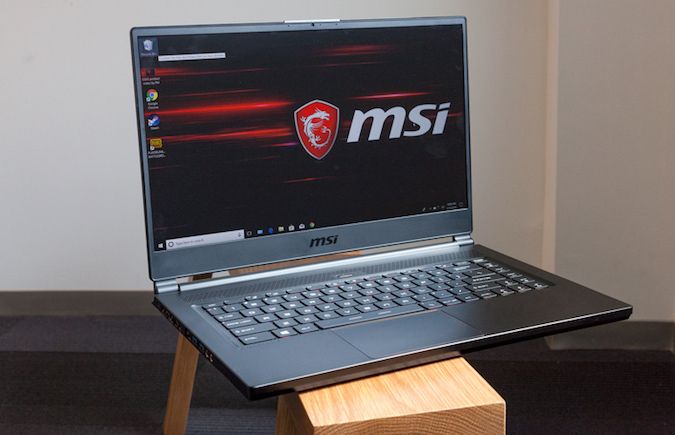Help Me, Laptop: What's the Best Max-Q Gaming Laptop?
Powerful gaming laptops are often chunky beasts, but Nvidia's Max-Q technology enables companies like Asus and MSI to create sexy, superslim alternatives. A Tom's Guide forum user asked us for help in finding the best Max-Q gaming laptop that you can get for a reasonable price.
Skuzzlebutt writes, "Here's my dilemma: The MSI [Stealth Thin] is going to be $3,000 with an [Intel Core i7-8750H CPU, a GTX] 1070, [32GB of RAM], [a] 1TB SSD and Windows 10 Pro. On the other side, weighing in at just over $2,800, [there's the] Asus ROG Zephyrus, sporting an [Intel Core i7-8750H CPU and a GTX] 1080, but at 16GB [of RAM and with a] 512GB SSD, and [it's] not Windows 10 Pro. They're both great-looking, but [I don't know] if the storage and Windows 10 Pro is worth the few hundred more in the MSI model."
Don't you worry, Skuzzlebutt — we're going to break down the two contending laptops and even throw in a bonus contender while we're at it.
MSI GS65 Stealth Thin: Best Battery Life and Display
The Stealth Thin (0.7 inches thin) that we tested ($1,999) had only 16GB of RAM and a 512GB SSD. Despite that, it scored 17,184 on the Geekbench 4 overall performance test and 44 frames per second on the Rise of the Tomb Raider benchmark (Very High, 1080p), making it more than capable of multitasking and running taxing games.
This machine's 15.6-inch, 1080p, 144-Hz panel can reproduce 150 percent of the sRGB color gamut and deliver 293 nits of brightness. That's incredibly vibrant, especially with this laptop's practically nonexistent bezels. Its battery is also incredibly impressive for a gaming laptop, lasting 5 hours and 40 minutes on the Laptop Mag Battery Test.
MORE: Longest Battery Life Laptops
Sign up to receive The Snapshot, a free special dispatch from Laptop Mag, in your inbox.
On top of that, the Stealth Thin has a surprisingly springy keyboard, at 1.4 millimeters of key travel. We typically recommend travel of from 1.5 to 2.0 mm, so while this keyboard doesn't necessarily make the mark, it's quite close.
Asus ROG Zephyrus: Best Graphics and Innovative Keyboard
The Zephyrus (0.66 inches thin) that we tested ($2,699) last year is a little out of date with its processor (Core i7-7700HQ), but its GTX 1080 banged out 58 fps on the Rise of the Tomb Raider benchmark. That performance could increase with the 8th Gen CPU in your configuration.
This laptop's 15.6-inch, 1080p, 120-Hz display covered 114 percent of the sRGB spectrum and hit 276 nits of brightness. It has a lower refresh rate and duller colors than the Stealth Thin, but the Zephyrus' panel is powered with Nvidia's G-Sync technology, which helps eliminate screen tears and deliver smoother images. Unfortunately, the Zephyrus lasted only an abysmal 1 hour and 57 minutes on our battery test.
Despite some low key travel (1.3 mm), the Zephyrus wowed us with its forward-facing keyboard layout. It may take a little while to get used to, especially due to the lack of palm rests, but the positioning of the touchpad on the right side makes it a lot easier to play games and browse the web. Still, this touchpad can't replace a full-blown gaming mouse for precision.
Asus ROG Zephyrus S: Best Value and Performance In the Slimmest Design
If you took the Zephyrus and packed it in a smaller footprint for a much cheaper price, you'd get the Zephyrus S (0.62 inches thin), which sells for $1,849 at the time of writing. It comes with a Core i7-8750H processor, a GTX 1070 GPU, 16GB of RAM and a 512GB SSD, which hit 20,453 on Geekbench 4 and averaged 46 fps on the Rise of the Tomb Raider benchmark.
This laptop's 15.6-inch, 1080p, 144-Hz screen hit 113 percent of the sRGB color gamut and produced 335 nits of brightness, making it the brightest display here, with thinner bezels than its predecessor. The battery lasted a little longer than its sibling's, at 3 hours and 33 minutes.
MORE: Best Graphics Performance
The Zephyrus S has the same forward-facing keyboard and touchpad layout as the original Zephyrus, but the keys have a measly 1mm of travel, making the machine uncomfortable to type on.
Bottom Line
The Zephyrus S is around $1,000 cheaper than your current options and offers faster raw performance in a slimmer design, so we ultimately recommend getting that based solely on the price.
You don't really need 32GB of RAM to properly run games; 16GB is just fine. On top of that, the original Zephyrus does have a much better GPU, which would make up for the MSI's better RAM.
If you don't keep that many games installed at once, you shouldn't have a problem with a 512GB SSD. And concerning Windows 10 Pro, if you don't plan on using Microsoft tools like Word and Excel, then it's simply not worth it.
The cost of these additions would be more well-spent in getting a better graphics card or second display. At the same time, the MSI Stealth Thin does have a better battery life and display than the Zephyrus.
We hope that this helped. Let us know which you decide to go with!
Credit: Laptop Mag

Rami Tabari is the Reviews Editor for Laptop Mag. He reviews every shape and form of a laptop as well as all sorts of cool tech. You can find him sitting at his desk surrounded by a hoarder's dream of laptops, and when he navigates his way out to civilization, you can catch him watching really bad anime or playing some kind of painfully difficult game. He’s the best at every game and he just doesn’t lose. That’s why you’ll occasionally catch his byline attached to the latest Souls-like challenge.




